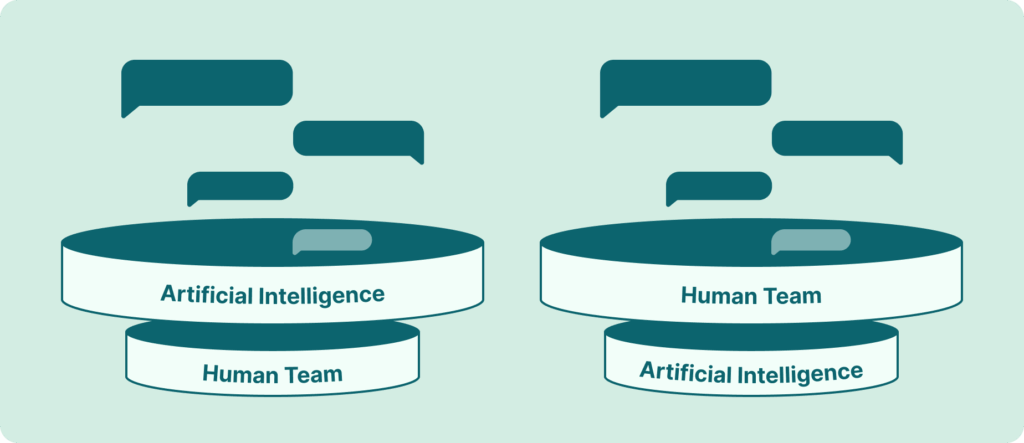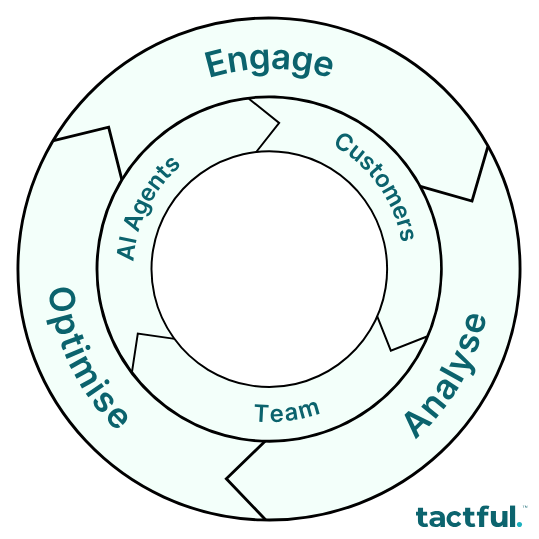Introduction
A friend of mine runs a retail business. He recently asked, “How do I start using conversational AI?” It made me realise this is a question many business owners are asking today.
Customers now expect fast answers, all day, every day. They want smooth support whether they message you on your website, Instagram, or WhatsApp. At the same time, your support team is likely feeling overwhelmed.
If you’re trying to grow your business without hiring a bigger support team, this guide is for you. In this post, I’ll walk you through a clear plan for using conversational AI. You don’t need to be a tech expert to follow it.
We’ll cover:
- What conversational AI is (and what it’s not)
- How to spot the best areas to use it
- When to let AI help, and when to use humans
- Common mistakes to avoid
Whether you’re just starting or want to improve what you already use, this guide will help you move forward with confidence.
Let’s get into it.
Is This Guide Right for You?
Before you jump into setting up conversational AI, let’s align on a few common situations many retail and e-commerce businesses face. These assumptions will help you see if this guide fits your current stage.
Assumption 1: You want to grow sales, improve customer service, and reduce operational costs
You’re likely aiming to boost revenue, make your customers happier, and lower support costs. These are the most common goals we see with brands exploring AI.
Assumption 2: You already have a support team
Maybe it’s just one or two people, or maybe a larger group. Either way, they spend their day helping customers with sales inquiries and service requests.
Assumption 3: You’re active across one or multiple channels
You have a website, and your customers are messaging you through Instagram, WhatsApp, and other platforms. The more you grow, the more messages you get.
Assumption 4: Your team is stretched thin
Support tickets are piling up. Some customers wait too long. Your team is stressed, and you’re starting to worry about how to keep up.
Assumption 5: You still see support as a cost centre, not a growth engine
Many businesses still treat customer service as an expense to minimise, rather than a powerful tool to drive loyalty and revenue. If this is the case, you may be underinvesting in areas that could directly impact growth.
If some or all of these sound familiar, then you’re in the right place. The next chapters will show you how conversational AI can ease the pressure, improve service, and unlock growth without adding more headcount.
What Conversational AI Is and What It’s Not

Before you explore how to use conversational AI, it’s important to clear up a big myth: not every chatbot is truly “conversational AI.” Let’s break down the differences.
The Old Way: Rule-Based Chatbots
These are the classic bots many businesses started with. They use buttons and predefined paths to help customers find answers. For example:
- Press 1 for English
- Press 2 for Delivery Questions
- Choose Your City
These bots follow a fixed script. If a question falls outside their flow, they usually can’t help.
The Next Step: NLU-Based Chatbots
NLU (Natural Language Understanding) bots try to detect the meaning behind what a customer types. You train them to recognise certain phrases and match them with preset answers.
But they often struggle when questions sound similar. For example:
- “Do you deliver to Leicester?”
- “How much is delivering to Leicester?”
- “Is express delivery available?”
They may mix up these intents and give the wrong answer. That leads to poor customer experiences.
What True Conversational AI Looks Like
Modern conversational AI is powered by LLMs (Large Language Models). Instead of picking from a few answers, it can understand your customer’s message, pull the right data from your knowledge base, and generate a clear response in real time.
It feels more like talking to a helpful human than clicking through a robot menu.
And It Can Do More Than Just Chat
With the help of agentic AI workflows, conversational AI can take action, not just answer questions. For example:
- Checking an order status
- Starting a return
- Creating a support ticket for a human agent to handle
- Routing a message to the right agent or store
This isn’t just about saving time. It unlocks better customer experience, faster resolutions, and less pressure on your team.
In the next chapter, we’ll explore how to blend AI with your human team to get the best of both worlds.
Finding the Right Balance Between AI and Humans

One of the most common concerns about adopting AI is the fear of replacing human agents. But in reality, the best results come from combining both. Think of AI as an assistant that works alongside your team, not instead of them.
Option 1: AI as the First Line of Support
In this setup, AI handles the initial interaction. It takes care of common questions, repetitive tasks, and low-risk actions like:
- Answering “Where is my order?” (WISMO), which can account for 25% to 40% of all customer inquiries in typical retail and e-commerce businesses
- Answering questions based on your knowledge base, such as store hours or return policies
- If an inquiry is too complex or sensitive, AI can route the conversation to a human agent with all the context attached
- Gathering the right information and creating support tickets that your team can process later, reducing risk and ensuring governance
Option 2: Human First, AI Second
Some businesses, especially in luxury or hospitality, prefer to start with a human touch. AI can step in later to:
- Route the right customer to the right agent based on availability, language, agent skill, urgency, or other criteria
- Step in during peak hours when agents are overloaded
- Help after hours when your team isn’t available
- Suggest replies or next steps to the agent in real time
- Escalate issues to team leads if an agent handles a situation inappropriately or when high-risk factors are detected
This approach keeps the personal experience intact while making the team more efficient.
Option 3: Hybrid by Use Case
You don’t have to choose one or the other for everything. Many companies use AI for specific scenarios, like handling:
- Post-sale questions
- Delivery tracking
And they keep more complex or high-emotion interactions, like refunds or complaints, for their team.
The right balance depends on your brand, your customers, and your team capacity. But in all cases, blending AI and humans the right way will reduce response times, boost satisfaction, and protect your team from burnout.

The Engage. Analyse. Optimise. Framework by Tactful AI
Once you understand the value of conversational AI, the next step is knowing how to implement it without chaos. That’s where Tactful’s simple framework comes in: Engage > Analyse > Optimise > Repeat.
Step 1: Engage
Connect your existing channels, like website chat, Instagram, or WhatsApp, into a single inbox. This allows your team (and AI) to handle all conversations from one place.
Benefits:
- Centralised view of all customer interactions
- Faster response times
- Creates a critical mass of conversation data to analyse in the next step
If you’re starting from scratch, begin with the channels where your customers are most active. Avoid connecting every channel at once.
Step 2: Analyse
After you centralise your channels, take time to review real conversations. Look for:
- Most frequently asked questions
- Common complaints or frustrations
- Repetitive and time-consuming but simple requests (like WISMO)
- High-risk vs. low-risk interactions
This gives you a clear picture of what to automate and where human support is most needed.
Step 3: Optimise
Now it’s time to take action:
- Add knowledge base content to power AI answers
- Create agentic workflows for repetitive tasks (like order tracking or returns)
- Set up smart routing rules based on language, urgency, or agent skill
- Train your team on how to work alongside AI
You can start small and improve over time. The beauty of this model is that it’s cyclical: as your business grows, you repeat the process to continuously scale and improve.
Engage. Analyse. Optimise. Repeat.
It’s a proven path to deliver faster, smarter service, without overwhelming your team or losing the human touch.
Quick Wins to Automate First
If you’re not sure where to start automating, go for the quick wins. These are the common, low-risk conversations that eat up your team’s time but don’t need a human touch. Automating them first builds trust in the system and shows fast results.
Top Candidates for Early Automation
- WISMO (Where Is My Order?)
- This one alone can make up 25% to 40% of all customer inquiries.
- AI can pull real-time tracking data and respond instantly.
- Content-Based Questions
- These include predictable inquiries such as:
- Delivery times & shipping costs
- Store or branch locations
- Return and refund policies
- Product availability, sizes, colours, or specifications
- AI can provide accurate answers from your knowledge base or catalogue using known rules and customer input.
- These include predictable inquiries such as:
- Intelligent Routing to the Right Team Member
- AI can classify incoming messages and route them based on inquiry type, agent skill, language preference, or urgency level.
- Examples include:
- Pre-sales questions going to the sales team
- Post-order issues routed to customer support
- Refund requests from French-speaking customers sent to French-speaking agents experienced in returns
- This improves first-response accuracy, reduces handovers, shortens resolution time, and ensures customers are matched with the best-fit agent.
- Automated Ticket Creation
- When no agents are available, AI can gather the necessary details and automatically create support tickets.
- These tickets include the context and intent of the inquiry, so your team can take over smoothly the next day.
- This ensures customers are acknowledged even outside working hours, helping you reduce SLA breaches and improve service consistency.
Why Quick Wins Matter
- Show early ROI to your team and leadership
- Free up agents for more complex or high-value conversations
- Increase response speed and satisfaction instantly
Once you see success here, you can move on to more advanced automation, like multi-step workflows and decision-based routing.
Common Pitfalls to Avoid

While conversational AI can bring major improvements, rushing into it without a plan often leads to frustration. Here are some of the most common mistakes businesses make when implementing AI, and how to avoid them.
Mistake 1: Automating Everything Too Soon
It can be tempting to automate as much as possible right away. But this usually leads to broken conversations and frustrated customers.
What to do instead:
Start with low-risk, high-volume tasks (like WISMO). Let AI prove its value and earn trust before expanding to complex interactions.
Mistake 2: Skipping the Analysis Phase
Jumping into automation without reviewing your actual conversations means you are guessing what customers need.
What to do instead:
Use your centralised inbox to study what people ask, how agents respond, and where bottlenecks happen. Build automation from real patterns, not assumptions.
Mistake 3: Treating All Channels the Same
Each channel has its own behaviour patterns and customer expectations. What works on website chat may not work the same way on WhatsApp.
What to do instead:
Connect all conversational channels to a unified inbox for your team, but roll out AI one channel at a time. Measure impact. Learn and adjust before moving to the next.
Mistake 4: Ignoring the Human Touch
AI can scale your support, but it cannot replace empathy or judgment.
What to do instead:
Blend AI with human agents. Let AI take care of the routine, and keep humans in the loop for edge cases and sensitive conversations.
Avoiding these mistakes ensures a smoother rollout and a better experience for both your team and your customers.
Real-World Impact: Smarter Service, Happier Customers
Once you implement conversational AI thoughtfully, the results speak for themselves. Let’s look at how real businesses are transforming their support experience using this technology.
Case Example: Reducing Phone Queue Overload
A retail brand we worked with used to have long wait times on phone support. Many callers were just looking for order updates or store info. These were low-complexity tasks that tied up valuable agent time.
The solution:
They added a simple IVR message: “Press 1 to skip the queue and get a WhatsApp link to chat with us instantly.”
Once the customer pressed 1, they received a direct message with a link to the company’s live chat. AI handled most of the questions, while complex cases were routed to a human.
The result:
- Call queue volume dropped dramatically
- Customer satisfaction scores increased
- Sales conversions from chat went up
Why It Works
- Customers get faster answers
- Agents are freed up to handle complex conversations
- You reduce support costs while improving outcomes
Whether you’re a hotel, fashion brand, electronics store, or grocery delivery platform, the right AI setup helps you serve more customers with less effort.
The key is to start simple, measure often, and optimise continuously.
Ready to Start? Here’s What to Do Next
If you’ve made it this far, you’re likely serious about improving your support experience. The good news is that you don’t have to overhaul your entire operation to get started with conversational AI. Here’s how to take the first step:
1. Map Your Channels and Workflows
List all the ways customers reach you: website chat, WhatsApp, Instagram DMs, etc. Note who handles what, and where things tend to break down or get delayed.
2. Connect Everything to a Unified Inbox
Bring all those conversations into one place. This gives you visibility, control, and a base to layer AI on top. It also builds the data you’ll need to train smarter automation later.
3. Start with One Use Case
Pick a low-risk, high-volume task like WISMO. Automate that first and monitor the results.
4. Loop in Your Team Early
Show your support agents how AI will help them, not replace them. Get their feedback and keep them part of the process.
5. Keep Iterating
AI is not a one-and-done setup. The most successful brands treat it like a living system: improving responses, expanding coverage, and fine-tuning workflows as they go.
Final Thought
You don’t need to be a tech company to deliver modern, AI-powered support. You just need the right mindset, the right partners, and a step-by-step approach.
When you’re ready to explore how this could look for your business, reach out. We’re happy to help you design the right path forward.




